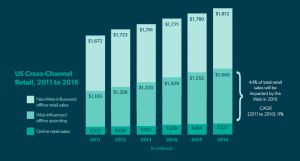The Assisted Reality Of The New Marketer
by Gord Hotchkiss , Featured Contributor, August 22, 2017
Last week, MediaPost’s Laurie Sullivan warned us that the future of analytical number crunchers is not particularly rosy in the world of marketing. With cognitive technologies like IBM’s Watson coming on strong in more and more places, analytic skills are not that hot a commodity anymore.
Ironically, when it comes to marketing, the majority of companies have not planned to incorporate cognitive technologies in the near future. According to a report from IBM and Oxford Economics, only 24% of organizations have a plan to incorporate CT in their own operations.
Another study, from Forrester, explored AI marketing readiness in the retail and e-commerce sectors. Here, the state of readiness is a little better. In these typically forward-thinking sectors, 72% are implementing AI marketing tech in the next year, but only 45% of those companies would consider themselves excelling in at least two out of three dimensions of readiness.
If those numbers seem contradictory, we should understand the difference between cognitive technology and artificial intelligence. You’ll notice that IBM refers to Watson as “cognitive computing.” As Rob High, IBM’s CTO for Watson put it, “What it’s really about is involvement of a human in the loop,” and he described Watson as “augmented intelligence” rather than artificial intelligence.
That “human in the loop” is a critical difference between the two technologies. Whether we like it or not, machines are inevitable in the world of marketing, so we’d better start thinking about how to play nice with them.
I remember seeing a video from the IBM Amplify summit at a MediaPost event last year. Although the presentation was a little stilted, the promise was intriguing. The video showed a marketer musing about a potential campaign and throwing “what-ifs” at Watson, who quickly responded with almost instantly analyzed quantified answers.
The premise of the video was to show how smart Watson is. But here’s a “what if” to consider: What if the real key here was the hypotheticals that the human seemed to be pulling out of the blue? That doesn’t seem so impressive to us — certainly not as impressive as Watson’s crunching relevant numbers in the blink of an eye. Musing is what we do. But this is just one example of something called Moravec’s Paradox.
Moravec’s Paradox, as stated by AI pioneer Marvin Minsky, is this: “In general, we’re least aware of what our minds do best. We’re more aware of simple processes that don’t work well than of complex ones that work flawlessly.”
In other words, what we find difficult are the tasks that machines are well-suited for, and the things we’re not even aware of are the things machines find notoriously hard to do. Things like intuition — and empathy. If we’re looking at the future of the human marketer, we’re probably looking at those two things.
In his book “Humans are Underrated,” Geoff Colvin writes, “Rather than ask what computers can’t do, it’s much more useful to ask what people are compelled to do — those things that a million years of evolution cause us to value and seek from other humans, maybe for a good reason, maybe for no reason, but it’s the way we are.”
We should be ensuring that both humans and machines are doing what they do best, essentially erasing Moravec’s Paradox. Humans focus on intuition and empathy and machines do the heavy lifting on the analyzing and number-crunching. The optimal balance — at this point, anyway — is a little bit of both.
In “Descartes’ Error,” neurologist Antonio Damasio showed that without human intuition and emotion — together with the corresponding physical cues he called somatic markers — we could rationalize ourselves into a never-ending spiral without ever coming to a conclusion. We need to be human to function effectively.
Researchers at MIT have even tried to put this idea into an algorithm. In 1954, Herbert Simon introduced a concept called bounded rationality. This may seem to put limits on the cognitive power of humans — but as programmers like to say, bounded rationality is a feature, not a bug.
The researchers at MIT found that in an optimization challenge, such as finding the optimal routing strategy for an airline, humans have the advantage of being able to impose some intuitive limits on the number of options considered.
For example, a human can say, “Planes should visit each city at the most once,” and thereby dramatically limit the number-crunching required. When these intuitive strategies were converted to machine language and introduced into automated algorithms, those algorithms got 10% to 15% smarter.
When it comes right down to it, the essence of marketing is simply a conversation between two people. All the rest: the targeting, the automation, the segmentation, the media strategy — this is all just to add “mass” to marketing. And that’s all the stuff that machines are great at.
For us humans, our future seems to rely on our past — and on our ability to connect with other humans.
MediaPost.com: Search Marketing Daily
(99)
Report Post




